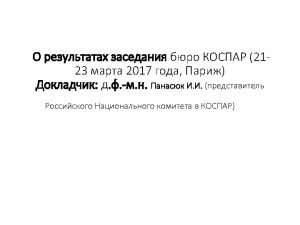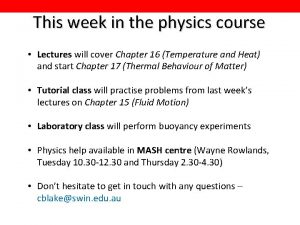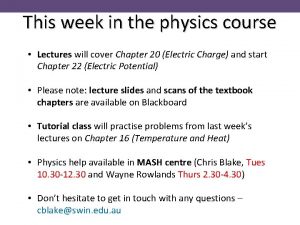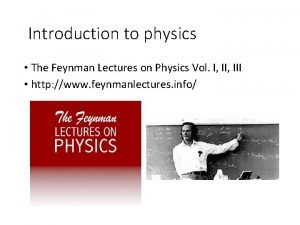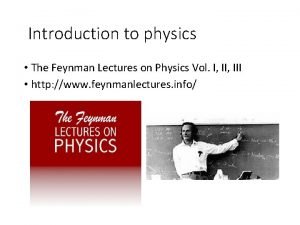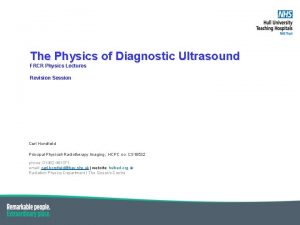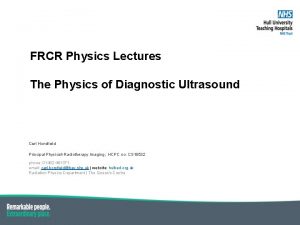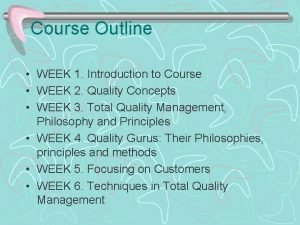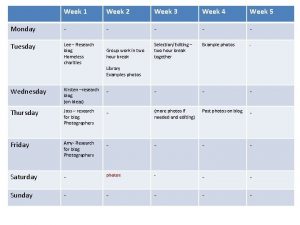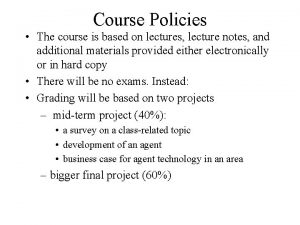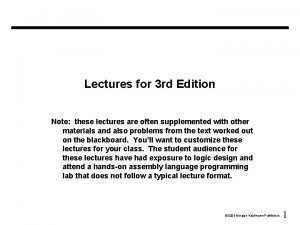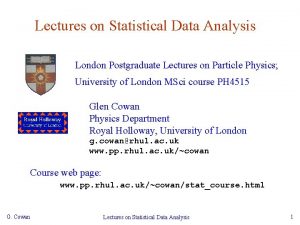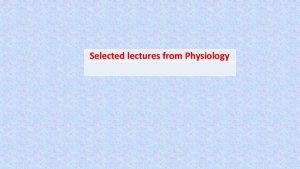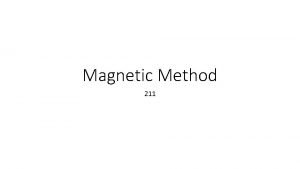This week in the physics course Lectures will





































- Slides: 37

This week in the physics course • Lectures will cover Chapter 24 (Electric Current) and start Chapter 25 (Electric Circuits) • Please note: lecture slides and scans of the textbook chapters are available on Blackboard • Tutorial class will practise problems from Chapter 17 (Thermal Behaviour of Matter) • Physics help available in MASH centre (Chris Blake, Tues 10. 30 -12. 30 and Wayne Rowlands Thurs 2. 30 -4. 30) • Don’t hesitate to get in touch with any questions – cblake@swin. edu. au

Chapter 22 summary

Chapter 24 : Electric current • How do we define current? • Macroscopic and microscopic description of current • Ohm’s law and resistance • Electrical power

Electric current • A flow of charge is called an electric current

Electric current • A flow of charge is called an electric current • The current (symbol I) is the amount of charge Q [in Coulombs] flowing per unit time t [in seconds] • The units of current are C/s or “Amperes” A

Electric current • Current is in the direction that positive charge flows • But in reality, current is transported by an opposite flow of negatively-charged electrons Sometimes described as “conventional current” (positive) or “electron current” (negative)

In which wire(s) are there electrons moving from right to left? 1. 2. 3. 4. 5. 6. Z only X only Y only X and Y Y and Z X, Y and Z X Y Z I electron current conventional current

Electric current • How do we create an electric current? • Create an electric potential difference between two points • Connect those points to allow charge to flow Circuit symbols! • Dissipate the energy (e. g. into light, heat)

Only one terminal of the battery is connected to the light bulb. What happens? 1. No current flows 2. A very small current flows 3. A current flows for only a short time 4. Current flows at half the rate it flowed with two wires

Electric current • Electrical power may be supplied as either a direct current or an alternating current • We will only cover direct current in this topic

Macroscopic vs. Microscopic • In physics and chemistry we try and relate the overall macroscopic properties of a system to its microscopic nature

Microscopic nature of current • What really happens when a battery is connected? • (1) As we saw in the “temperature” topic, particles are in constant thermal motion +q +q +q

Microscopic nature of current • What really happens when a battery is connected? • (2) The battery supplies a potential difference hence electric field E +q +q +q

Microscopic nature of current • What really happens when a battery is connected? • (3) The charges feel a force from the electric field and start to accelerate E +q +q +q

Microscopic nature of current • What really happens when a battery is connected? • (4) The charges undergo collisions with the other particles in the material which slows their motion E +q

Microscopic nature of current • What really happens when a battery is connected? • (5) These collisions produce a resistance to motion which results in an equilibrium drift velocity

Microscopic nature of current • What really happens when a battery is connected? • (5) These collisions produce a resistance to motion which results in an equilibrium drift velocity

Microscopic nature of current • How much current is produced by drift velocity v? x +q +q v v +q A v Number density of charges = n

Microscopic nature of current Exercise: A 5 -A current flows in a copper wire with crosssectional area 1 mm 2, carried by electrons with number density 1. 1 x 1029 m-3. What is the electron drift speed? Isn’t this incredibly slow? Yes – but the electric field itself is established at the speed of light.

Microscopic nature of current • The current density (symbol J) is the current flowing per unit area (“concentration of current”) • The units of J are A/m 2 • Used in a microscopic description of current

Ohm’s Law : macroscopic version

Ohm’s Law : electrical shock

Ohm’s Law : microscopic version

Ohm’s Law : “lie detection” • Sweat increases the conductance of the skin, which will change the current flowing for fixed voltage “machines do detect deception better than chance, but with significant error rates”

Ohm’s Law : microscopic version

Ohm’s Law : microscopic version Exercise: If the starter motor draws a current of 170 A, what’s the potential difference across the wire?

Macroscopic vs. Microscopic

Electric current • Current can be measured using an ammeter

Two electrical measuring devices, X and Y, are placed in the circuit as shown to measure properties of the resistor. Which of the following descriptions is correct? 1. 2. 3. 4. X Y X measures current, Y measures voltage X measures voltage, Y measures current X and Y measure voltage Current is measured at a location – ammeters in series. Voltage (potential difference) between two locations – voltmeters in parallel.

How does the current entering the resistor, I 1, compare to the current leaving the resistor, I 2? I 2 I 1 1. I 1 < I 2 2. I 1 > I 2 3. I 1 = I 2 CHARGE CONSERVATION: charge cannot be created or destroyed. Energy is dissipated as current flows through a resistance, but charge is conserved, so current in = current out.

Electric power

Electric power • This power is dissipated as heat energy in the resistance – why electrical components get hot!

Electric power • Power is measured in Watts (1 W = 1 J/s) • Your “power bill” is probably measured in “k. Wh” or “kilo-Watt hours” • This is really an “energy bill” … • 1 k. Wh = 1000 J/s x 3600 s = 3. 6 x 106 J = 3. 6 MJ

Electric power • Why do power lines operate at 100, 000 V? • P = V I : high power can be delivered using high V or high I • Some power will be lost in heating the transmission wires • P = I 2 R : low current minimizes these transmission losses

Electric power Exercise: What is the resistance of a 60 W 240 V light bulb? Power P = 60 W Voltage V = 240 V Exercise: What would be the power output if the bulb was plugged into the US mains of 110 V?

Thermal runaway and fuses For most conductors, resistance is not completely constant, but increases with increasing temperature. If part of a circuit starts to overheat, its resistance can increase, causing larger power dissipation, causing higher resistance etc. A fuse protects a circuit from general damage by acting as the “weak point”; a thin wire that will physically fail (melt) if current exceeds a safe level. “Circuit breakers” or “safety switches” either mechanical or electronic, are now able to offer faster and more reliable protection.

Chapter 24 summary
 Frcr physics lectures
Frcr physics lectures Rotating anode
Rotating anode Week by week plans for documenting children's development
Week by week plans for documenting children's development English bond t junction
English bond t junction Course number and title
Course number and title Chaine parallèle muscle
Chaine parallèle muscle Rick trebino
Rick trebino Neonatology lectures
Neonatology lectures Data mining lectures
Data mining lectures Medicinal chemistry lectures
Medicinal chemistry lectures Uva powerpoint
Uva powerpoint Ludic space
Ludic space Step wise project planning
Step wise project planning Molecular biology lecture
Molecular biology lecture Radio astronomy lectures
Radio astronomy lectures Dr sohail lectures
Dr sohail lectures Utilities and energy lecture
Utilities and energy lecture Introduction to web engineering
Introduction to web engineering How to get the most out of lectures
How to get the most out of lectures Introduction to recursion
Introduction to recursion Guyton physiology lectures
Guyton physiology lectures Define aerodynamics
Define aerodynamics Theory of translation lectures
Theory of translation lectures Power system lectures
Power system lectures What is text linguistics
What is text linguistics Translation 1
Translation 1 Digital logic design lectures
Digital logic design lectures Computer networks kurose
Computer networks kurose What is hegelian philosophy
What is hegelian philosophy Nuclear medicine lectures
Nuclear medicine lectures Gpoint c++
Gpoint c++ Cdeep lectures
Cdeep lectures Oral communication 3 lectures text
Oral communication 3 lectures text C programming lectures
C programming lectures Haematology lectures
Haematology lectures Bureau of lectures
Bureau of lectures Slagle lecture
Slagle lecture Theory of translation lectures
Theory of translation lectures



































